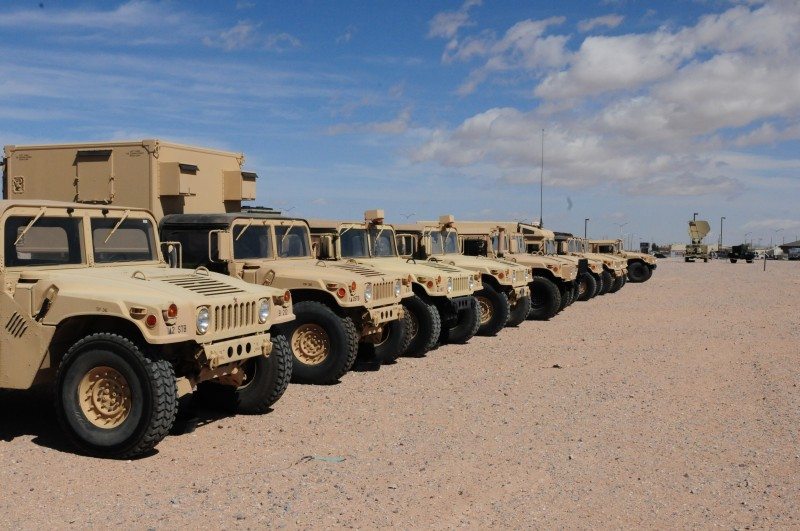As preparations for the Army’s Network Integration Evaluation kick into high gear, Soldiers, engineers, combat developers and test officials are joining forces at Fort Bliss, Texas, and White Sands Missile Range, N.M.
The NIE, scheduled to get underway in earnest by June at White Sands, will be the Army’s largest and most robust network test and evaluation effort to date, according to program officials.
“We have hundreds of subject-matter experts from the test, acquisition and requirements communities converging at Fort Bliss to begin integration work in support of the Army’s top modernization priority … delivering an integrated network that will be evaluated during the June through July Network Integration Evaluation,” said Col. John Wendel, deputy program executive officer for Networks, PEO Integration.
“This is a monumental effort and it requires a new level of integration, so we have assembled the right team to make sure we can synchronize the technologies into a composite brigade formation while working to ensure proper instrumentation from a data collection standpoint,” Wendel said.
Wendel and his team are in charge of the synchronization and integration of network capability to support the NIE. These personnel, plus numbers that continue to increase weekly, will maintain a permanent presence at Fort Bliss through the end of July to support ongoing NIE efforts.
The NIE has been termed “the largest operational test in the history of the U.S. Army Operational Test Command, in terms of number of systems being tested and number of personnel supporting.” This year’s NIE is actually the first of a series of four major test and evaluation events aimed at synchronizing multiple programs and evaluating technologies to determine how well they fit into a larger, integrated tactical network, according to the Army Test and Evaluation Command.
The culminating event in late 2012 will help slate the content for the first Capability Set to be fielded to deploying brigades in the 2013-2014 timeframe. A Capability Set is a total package of networked and non-networked hardware and software fielded to a particular unit.
“The June/July NIE is not a stand-alone ‘pass/fail’ event, but the first of four major stepping stones leading to executing a fully integrated Brigade Combat Team Network Evaluation at the end of 2012,” said Paul Mehney, spokesman for PEO Integration. “These events are not individual activities, but part of a culminating process that will allow the Army to build the network and then fill it with the best applications and systems that the network can handle.”
Additional preparations are being made at the 2nd Brigade Combat Team, 1st Armored Division, which will be executing the six-week test and evaluation. The 4,000-plus Soldiers from this unit will make up the first full brigade the Army has used in its test/evaluation process. They have spent the past several months preparing for the NIE in both field training and classroom exercises.
Currently, 2/1 AD is participating in Battle Command System of Systems Integration training at Fort Bliss, designed to train the unit to use all current command post equipment in a battle command environment. During the 12-day training exercise that commenced March 14, Soldiers established both brigade- and battalion-level networked command posts and are participating in intensive integration training.
“The goal is to build the infrastructure and architecture of a fully operational tactical operations center – 14 large ‘tents’ filled with the unit’s own equipment,” said Maj. Rick Galeano of 2/1 AD. “This not only ensures the unit has the right level of connectivity to deliver mission command information to the Brigade prior to going out into the field, but also determines how emerging network capabilities at both lower and higher tactical levels will integrate into the command post and then communicate with each other.”
Establishing a baseline with current capabilities at the brigade and battalion-level will allow the unit to better assess how new capabilities at the platoon and company level will integrate with current and/or theater-provided systems during follow-on communications exercises scheduled in May. Additionally, the exercise provides an opportunity for the brigade to carry out various tasks including: validate command-post infrastructure and network; manage tactical information; learn how to restore capability in case of network malfunction; and create a common operational picture.
Many brigade Soldiers are also enrolled in daily classroom training to learn how to integrate and operate everything from the Joint Tactical Radio System Ground Mobile Radio, known at JTRS GMR, to remote weapons delivery systems, to connecting Soldiers to digital applications, known as CSDA – an Army initiative aimed at developing and evaluating handheld applications and capabilities.
Soldiers attend the classes at brigade headquarters, where there are six large new classrooms that can accommodate up to 40 Soldiers in each. Others attend equipment training on acres of sprawling motor-pool lots, teaming with the latest Army combat and tactical vehicles including Strykers and fully-outfitted M-ATVs. As integration efforts progress, the brigade will begin “new equipment training, or NET, in April with the systems they will be testing and evaluating during NIE.
In June, the entire brigade with a cadre of test officials will occupy White Sands Missile Range for the start of the test and evaluations.
“By integrating systems across the 2nd Brigade, 1st Armored Division, we will ensure these capabilities get a thorough operational workout,” Wendel said. “When the Army fields network capabilities, not all Soldiers receive them at the same time. Part of our challenge during these upcoming rehearsal and evaluation events is to figure out how to make sure units who have the new capabilities can talk to units that don’t have all the new capabilities. It’s all about proper capability integration and real-world, Soldier-driven, operationally-relevant evaluations – that’s what this entire community is working to solve.”
(Katie Cain provides public affairs support to PEO Integration)










